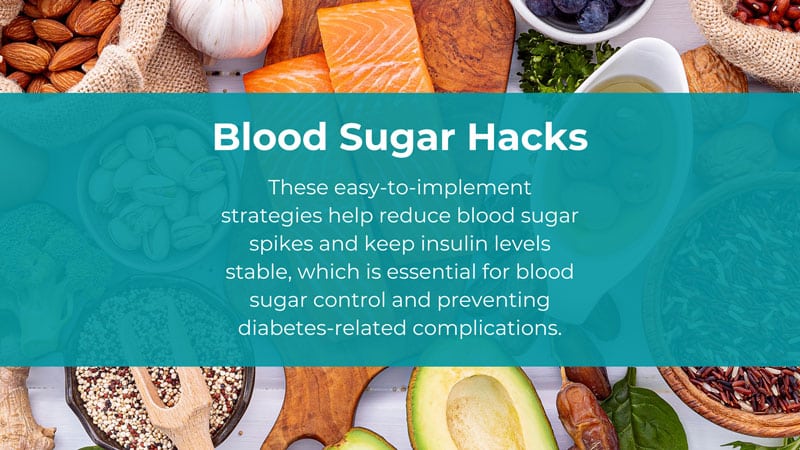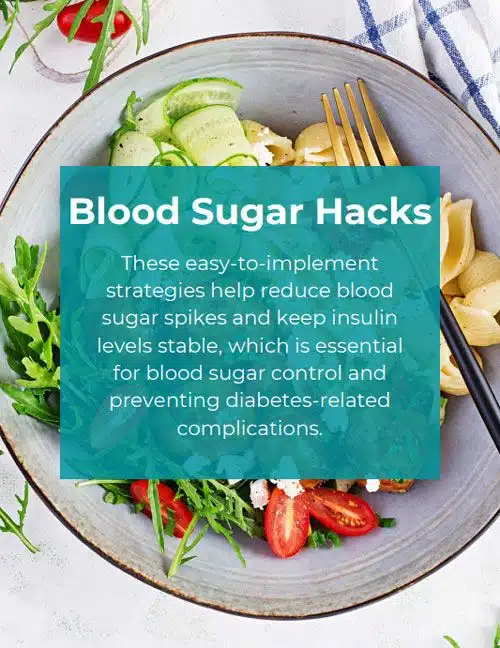Discover these simple blood sugar hacks to stabilize glucose levels, curb sugar cravings, and prevent glucose spikes for better health!

Balancing your blood sugar is essential for maintaining energy, reducing cravings, and promoting overall metabolic health. And despite soaring rates of diabetes, monitoring blood sugar has never been more popular. Instagram stars like Jessie Inchauspé, also known as the Glucose Goddess, have made a big splash talking about ways to hack your blood sugar in recent years.
Lucky for us, we have our own glucose expert in-house at FLCCC! Dr. Kristina Carman is back again with another jam-packed guide. This time, we explore simple hacks that can help you stabilize glucose levels and flatten glucose spikes. Whether you’re aiming to prevent type 2 diabetes, manage blood glucose levels, or simply feel better throughout the day, small adjustments to your diet and lifestyle can make a significant difference.
Grab the PDF below for some effective strategies you can use to balance your blood sugar and enhance your well-being.
1. Eat Plenty of Quality Protein, Healthy Fats, and Fiber to Balance Blood Sugar Levels
The foundation of effective blood sugar management lies in consuming a diet rich in high-quality proteins, healthy fats, and natural fibers. Incorporating foods like wild-caught fish, pasture-raised eggs, grass-fed beef, and organic beans provides essential protein and fat, which slow the absorption of glucose into the bloodstream. Healthy fats from nuts, seeds, olive oil, and fatty fish can prevent blood sugar spikes by moderating the release of glucose into the blood. Fiber from non-starchy vegetables and whole grains aids in stabilizing blood sugar levels by slowing down carbohydrate digestion. When choosing carbohydrates, aim for a 5:1 ratio of carbohydrates to dietary fiber to minimize glucose spikes.
2. Re-Organize Your Plate to Prevent Blood Sugar Spikes
The order in which you consume your food can significantly affect your blood glucose levels. By eating fibrous vegetables first, followed by healthy fats and proteins, and finishing with carbohydrates, you can reduce blood sugar spikes by up to 70%. This simple hack takes advantage of how different foods impact the release of glucose into your bloodstream. Starting your meal with a salad or leafy greens can help stabilize your blood sugar levels. If you indulge in carbs or sugary foods, reserving them for the end of your meal can prevent sharp increases in blood sugar, flattening your glucose spikes after a meal.
3. Consider Adding Vinegar to Flatten Glucose Spikes
Consuming vinegar before a meal is a proven strategy to flatten glucose spikes. A tablespoon of vinegar, especially apple cider vinegar, mixed with a glass of vinegar water can reduce post-meal blood glucose spikes by up to 30%. This hack works by slowing the absorption of glucose into the bloodstream, effectively reducing glucose absorption. If you’re pregnant, opt for pasteurized vinegar varieties. Alternatively, drizzling vinegar over a salad at the beginning of your meal can have a similar effect in preventing high blood sugar levels.

4. Prioritize Breakfast to Stabilize Glucose Levels
Your first meal of the day has a significant impact on your blood sugar balance. Eating a breakfast rich in protein and fat while low in carbohydrates can stabilize glucose levels and reduce sugar cravings throughout the day. Choosing savory over sugary foods helps prevent a spike in blood sugar that can lead to energy crashes and increased hunger. A balanced blood sugar level in the morning provides steady energy in the form of glucose, supporting better concentration and mood. This approach affects your glucose levels throughout the day and is particularly beneficial for people with diabetes or those at risk of developing type 2 diabetes.
5. Add Fermented Foods for Improved Insulin Sensitivity
Incorporating fermented foods like yogurt, kefir, and sauerkraut into your diet can improve insulin sensitivity and help manage blood sugar levels. The probiotics in these foods support a healthy gut microbiome, which plays a crucial role in glucose metabolism. Improved insulin sensitivity means your body can use insulin more effectively to control blood glucose levels, reducing the risk of insulin resistance and type 2 diabetes.
6. Get Adequate Sleep to Prevent High Blood Sugar
Lack of sleep is linked to blood sugar imbalance and can interfere with your body’s ability to regulate glucose. Poor sleep increases stress levels and affects insulin sensitivity, leading to higher blood sugar levels. Prioritizing 7-8 hours of quality sleep each night can help stabilize blood sugar levels, reduce stress hormones like cortisol, and prevent weight gain associated with high blood sugar levels.

7. Resistance Training to Enhance Glucose Uptake
Engaging in resistance training exercises, such as weightlifting or bodyweight workouts, helps build muscle mass, which is vital for glucose uptake. More muscle mass allows your body to use insulin more effectively, enabling glucose to be used by muscle cells, reducing excess glucose in the bloodstream. This not only helps manage blood sugar levels but also improves overall metabolic health. Regular resistance training is a key lifestyle factor in preventing blood sugar spikes and managing type 2 diabetes.
8. Hydration Matters for Managing Blood Sugar
Staying hydrated is essential for normal blood glucose levels. Dehydration can lead to higher blood sugar concentrations because there’s less water in the bloodstream, making it harder for your body to process glucose efficiently. Drinking water consistently throughout the day can help lower blood glucose spikes and support proper glucose metabolism. Aim for at least eight glasses of water daily to prevent high blood sugar and assist in glucose absorption.
9. Manage Stress to Reduce Blood Glucose Levels
High stress levels can cause spikes in cortisol, a hormone that raises blood sugar levels. Chronic stress is linked to blood sugar imbalances and can lead to insulin resistance, making it harder for your body to manage blood sugar. Incorporating stress management techniques like deep breathing, meditation, or yoga can help stabilize blood sugar levels by reducing cortisol production. Managing stress is a simple hack to improve your metabolic health and prevent weight gain associated with high blood sugar.

10. Add Fat to Your Carbs to Slow Glucose Absorption
If you enjoy snacking on carbs or indulging in desserts, adding healthy fats can help stabilize your blood sugar levels by slowing glucose absorption. This hack helps prevent rapid spikes in blood sugar levels by moderating the rate at which glucose enters the bloodstream, preventing spiking your blood sugar. For instance, spreading peanut butter on an apple or cracker, or mixing a spoonful of Greek yogurt into your dessert, can make a significant difference. The combination of protein and fat with carbohydrates slows down digestion and keeps your glucose levels stable.
11. Avoid or Minimize Snacking to Stabilize Blood Sugar
Frequent snacking can cause your blood sugar to rise continuously, leading to insulin resistance over time. Allowing your blood sugar and insulin levels to return to baseline between meals is essential for balancing your blood sugar. Instead of reaching for a snack, opt for water or tea. This practice helps manage your blood sugar more effectively and can reduce the risk of developing type 2 diabetes.
12. Check the Label to Avoid Hidden Sugars
Many packaged foods contain added sugars and artificial sweeteners that can spike your blood sugar levels. Even calorie-free sweeteners can affect your insulin production and harm your gut microbiome. Reading labels carefully to identify hidden sugars and high sugar content, such as barley malt or other deceptive names, is crucial. Reducing sugar content in your diet helps manage blood sugar levels and prevent blood glucose spikes. Being mindful of what you consume directly impacts your glucose levels and overall health.
13. Move After Eating to Lower Blood Sugar Spikes
Physical activity after meals is a powerful way to lower blood sugar spikes. Exercise helps your muscles absorb glucose from the bloodstream without relying heavily on insulin. Taking a walk, doing squats, or engaging in any form of movement after eating can significantly improve your blood sugar levels. This hack not only aids in glucose management but also enhances overall metabolic health. Continuous glucose monitoring shows that even light activity can lower blood glucose spikes and support normal blood sugar levels.

Wrapping Up
Balancing your blood sugar doesn’t have to be complicated. By implementing these simple hacks into your daily routine, you can control your blood sugar, stabilize glucose levels, reduce cravings, and improve your overall health. From adjusting the order of your food intake to incorporating resistance training and managing stress, these strategies you can use are effective for anyone looking to enhance their metabolic health.
Remember, small changes in your diet and lifestyle can lead to significant improvements in your blood sugar balance, helping you feel better and reducing the risk of developing type 2 diabetes. Enjoy the foods you love while making mindful choices that support your well-being.




